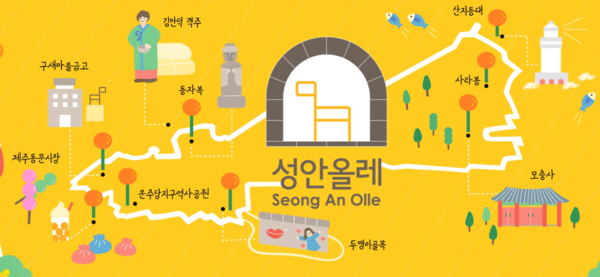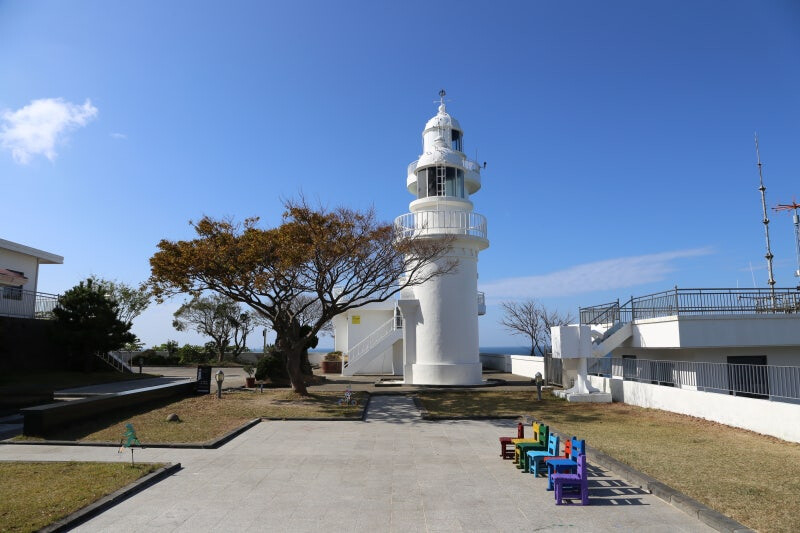
On a warm spring day, one finds solace and discovery along the Seongan Olle trails, pathways steeped in the thousand-year history of Tamna, the ancient kingdom that once flourished on Jeju Island. Upon the mythical birthplace of Jeju's three demigods, Goeulla, Yangeulla, and Bueulla, layers of time have accumulated, and stories long hidden in the annals of history emerge with each bend of the path. Set against the backdrop of Jeju City's original downtown area, the Seongan Olle offers a leisurely journey through time. Unraveling the myriad memories intertwined like threads over centuries, one may find a new perspective on the Jeju they thought they knew.
Jeju Port: A Gateway to History
The Seongan Olle, aptly named as a trail encircling the "Seongan" (within the fortress), invites exploration of the old heart of Jeju City. Though only remnants remain today, with some sections having been restored, a formidable fortress once stood here until the Japanese colonial era. It is believed that the fortress was constructed using the existing walls after Tamna Kingdom was fully incorporated into the Goryeo Dynasty. During the Joseon Dynasty, following the Eulmyo Invasion by Japanese pirates, the fortress area was expanded by drawing the Sanjicheon stream within its walls.
The Jeju Eupseong, a stronghold and last bastion protecting Jeju, was tragically dismantled entirely by the Japanese during the colonial period. To construct Jeju Port for resource exploitation, the fortress walls were demolished, and the stones were used to reclaim land from the sea. Consequently, artifacts spanning a rich history now lie buried beneath the ships traversing Jeju's waters. The history of the Jeju Eupseong, stretching back to the Joseon Dynasty, is intrinsically linked to the era of the Tamna Kingdom. Just as the old downtown area enclosed by the fortress walls is an ancient city steeped in a millennium of history, the Seongan Olle is a path that allows one to walk through this very history.
Seongan Olle: A Millennial Journey Whispering Tales of Ancient Tamna
The Seongan Olle comprises a circular route starting and ending at the Jeju Women and Family Research Institute, adjacent to the Sanjicheon stream. The first course explores Geonip-dong and Sara Peak, the second passes through Tapdong Plaza towards Yongyeon Valley, and the third leads through Dongmun Market to Samseonghyeol Shrine. Each course spans approximately 5 to 6 kilometers, making it feasible to complete all three in a single day for those with ample stamina. However, to fully appreciate the charm and stories embedded in each course, a leisurely pace, akin to a snail's crawl, is highly recommended. The narratives encountered along each path leave a lasting impression.
Seongan Olle Course 1: Where Weather Held Significance
The first course of the Seongan Olle immediately immerses walkers in historical remnants. Turning a corner from the starting point, a steep set of stairs appears, revealing a section of the original fortress wall preserved beneath a wooden deck. Stepping aside from the stairs, a sturdy stone wall, covered in ivy, becomes even more distinct. Considering that the entire Jeju Eupseong was essentially submerged in the sea, how did this particular section remain intact? The staircase overlaid on the fortress wall is said to have led to the meteorological observation station (now the Korea Meteorological Administration) established by the Japanese during their occupation. For ships carrying exploited resources to navigate safely, accurate weather forecasting was paramount. This might explain why the staircase to the observation station was left undisturbed.
Along the first course, one encounters the Dongjabok statue, a figure resembling the Dolhareubang (stone grandfather) and acting as a roadside mascot. While the exact origins of this large stone figure remain unclear, it has long been revered as a guardian deity protecting the village. Interestingly, a similar statue, the Seojabok, is found on the second course, positioned on the west side, facing the Dongjabok on the east – a curious symmetry.
Passing through the Geonip-dong mural village, adorned with numerous folktales depicted on its walls, the Sanji Lighthouse, standing for over a century, comes into view. Gazing out at the sea in front of the lighthouse, one can almost envision the fortress stones lying deep beneath the surface. At the foot of Sara Peak lies Mochungsa Shrine, a place imbued with the history of Jeju's resistance against Japanese rule. After traversing the charmingly painted Dumeongi Alley and the Unjudang Site Historic Park, the path leads to Dongmun Market, marking the approximate end of the first course.
Dongmun Market, the largest and oldest traditional market in Jeju, originated as makeshift stalls near the Namsugak stream after the liberation of Korea. It was relocated to its current site after a major fire in the 1950s. Inside the market, the refreshing scent of tangerines permeates the air year-round. With a plethora of souvenirs and unique snacks on offer, visitors might find their wallets considerably lighter if they are not careful.

Seongan Olle Course 2: A Modern History Returning Like a Boomerang
For those seeking a walk alongside the azure sea, the second course is an ideal choice. The coastal road extending from the end of the Seobudu breakwater stretches for about a kilometer along the shoreline. The area now occupied by hotels, large supermarkets, and tourist facilities was once a beach covered in black basalt pebbles. A large-scale land reclamation project began in the 1980s, facing strong opposition from local residents due to concerns about environmental pollution and the destruction of fishing grounds. Decades later, the consequences are returning like a boomerang. With a decrease in marine life and the disappearance of natural buffer zones against waves, angry swells occasionally surge over the breakwater, spilling white foam onto the roadside. The hidden stories of the Tapdong coastal road prompt reflection on the ongoing tension between development and preservation.
The path continues behind Yonghwasa Temple, where the Seojabok statue stands, and ascending a secret-passageway-like staircase leads to one of Jeju City's most breathtaking views: Yongyeon Valley. Formed at the confluence of Hallasan Mountain's waters and the Jeju sea, the valley's bizarre rock formations and transparent waters exude an air of mystery. During the Joseon Dynasty, this scenic spot was a popular destination for noblemen who would float boats and enjoy leisurely pursuits. Today's equivalent of this refined enjoyment is walking across the suspension bridge spanning the valley.
Passing Mugeunseong Street, one arrives at Gwandeokjeong Pavilion, where a large Dolhareubang, guarding the front of the fortress during the Joseon era, greets visitors. Gwandeokjeong, the oldest wooden building in Jeju, bears the painful history of the April 3rd Incident. In 1947, during a March 1st commemoration event held in the plaza in front of Gwandeokjeong, a mounted police officer struck a child, leading to police firing upon protesting citizens. This event served as a catalyst for the April 3rd Uprising. For a deeper understanding of this tragic period, a slight detour to the April 3rd History Museum at the former Cheju Prison Camp is recommended. Resuming the walk with this poignant history in mind, one encounters Ohyeondan Shrine, dedicated to five virtuous scholars, and Jeigak Pavilion, a former watchtower on the fortress walls. Passing through the Chilseongro shopping district and descending to Buksu-gu Plaza marks the completion of the second course.
Seongan Olle Course 3: The Birthplace of Tamna Kingdom
The final course, number three, follows the Sanjicheon stream upstream. Passing Dongmun Market and Jeigak Pavilion, the straight path leads to Samseonghyeol Shrine, the legendary birthplace of the Tamna Kingdom. This sacred site is believed to be where three demigods – Goeulla, Yangeulla, and Bueulla – emerged from the earth. Inside the shrine, three Moheungheol (holes of emergence) are preserved. These demigods are said to have married three princesses who arrived from Byeokrang Kingdom, establishing their respective settlements and laying the foundation for the Tamna Kingdom. The Go, Yang, and Bu clans, the indigenous surnames of Jeju, trace their origins back to these figures. Even today, ancestral rites honoring the three demigods are performed at Samseonghyeol, and the Geonsidaeje, a grand ancestral rite presided over by the Governor of Jeju Province, takes place annually in December. From early April, Samseonghyeol's grounds are adorned with cherry blossoms, and the sight of petals scattering in the breeze creates a scene more surreal than myth.
While the path continues towards Boseong Market and Gwangyang Catholic Church, visiting the Jeju National Museum of Natural History, located adjacent to Samseonghyeol, is a worthwhile option. After spending time exploring the vast space showcasing Jeju's history, culture, and ecology, one can rest at Shinsan Park behind the museum or grab a bite to eat at the noodle street across from it. Following the charming alleyways back towards Sanjicheon stream completes the time-traveling journey on foot. Though the path ends, the thousand years of history remain vividly in the heart.
Know Before You Go
Participating in the "Seongan Olle Walking Tour Program," offered from April to November, can greatly enrich the exploration of the trails. Every Saturday from 9:30 AM to 12:00 PM, a guide accompanies each course, providing explanations of the original downtown area's history and culture. Applications can be made through the Jeju Good Travel website. A reservation fee of 5,000 KRW is refunded in the form of Tamnaneun-jeon, the local currency, upon completion of the program. The audio guide app "Audi," created by the Korea Tourism Organization, also offers free commentary for the first and second courses of the Seongan Olle.
By weaving together historical context, cultural significance, and the natural beauty surrounding the Seongan Olle trails, this expanded article aims to provide a comprehensive and engaging overview for readers interested in exploring this unique historical and cultural asset of Jeju City.
[Copyright (c) Global Economic Times. All Rights Reserved.]




























